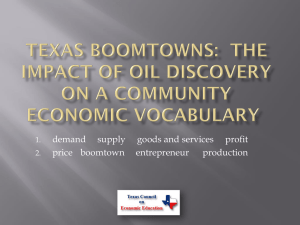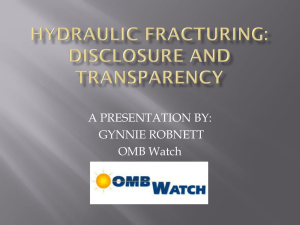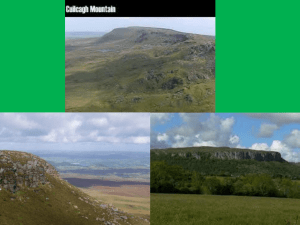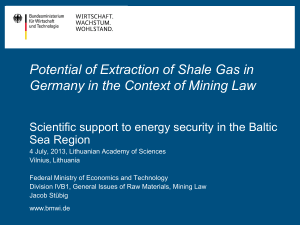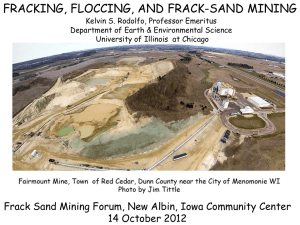Template Press Release - Athens County Fracking Action Network
advertisement
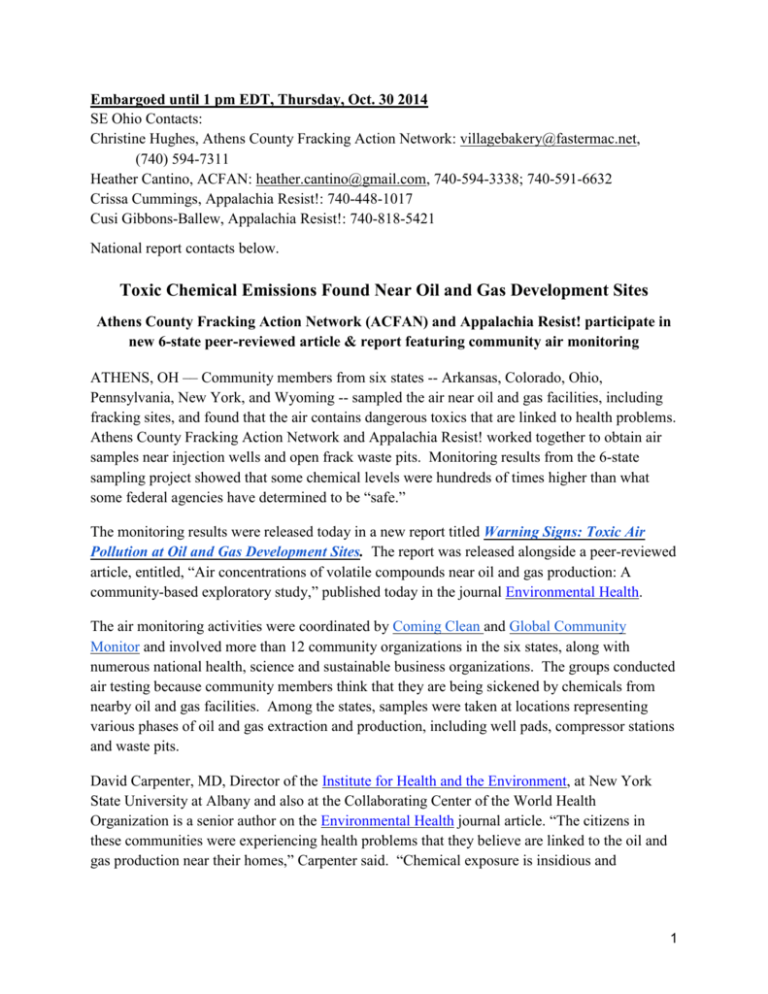
Embargoed until 1 pm EDT, Thursday, Oct. 30 2014 SE Ohio Contacts: Christine Hughes, Athens County Fracking Action Network: villagebakery@fastermac.net, (740) 594-7311 Heather Cantino, ACFAN: heather.cantino@gmail.com, 740-594-3338; 740-591-6632 Crissa Cummings, Appalachia Resist!: 740-448-1017 Cusi Gibbons-Ballew, Appalachia Resist!: 740-818-5421 National report contacts below. Toxic Chemical Emissions Found Near Oil and Gas Development Sites Athens County Fracking Action Network (ACFAN) and Appalachia Resist! participate in new 6-state peer-reviewed article & report featuring community air monitoring ATHENS, OH –– Community members from six states -- Arkansas, Colorado, Ohio, Pennsylvania, New York, and Wyoming -- sampled the air near oil and gas facilities, including fracking sites, and found that the air contains dangerous toxics that are linked to health problems. Athens County Fracking Action Network and Appalachia Resist! worked together to obtain air samples near injection wells and open frack waste pits. Monitoring results from the 6-state sampling project showed that some chemical levels were hundreds of times higher than what some federal agencies have determined to be “safe.” The monitoring results were released today in a new report titled Warning Signs: Toxic Air Pollution at Oil and Gas Development Sites. The report was released alongside a peer-reviewed article, entitled, “Air concentrations of volatile compounds near oil and gas production: A community-based exploratory study,” published today in the journal Environmental Health. The air monitoring activities were coordinated by Coming Clean and Global Community Monitor and involved more than 12 community organizations in the six states, along with numerous national health, science and sustainable business organizations. The groups conducted air testing because community members think that they are being sickened by chemicals from nearby oil and gas facilities. Among the states, samples were taken at locations representing various phases of oil and gas extraction and production, including well pads, compressor stations and waste pits. David Carpenter, MD, Director of the Institute for Health and the Environment, at New York State University at Albany and also at the Collaborating Center of the World Health Organization is a senior author on the Environmental Health journal article. “The citizens in these communities were experiencing health problems that they believe are linked to the oil and gas production near their homes,” Carpenter said. “Chemical exposure is insidious and 1 cumulative, and so it may take years to really understand the magnitude of impacts on people’s health from oil and gas development.” Athens County's new K&H facility, located near Torch, Ohio, has 11 large tanks that vent volatile organic compounds and hydrocarbons 24-hours a day less than one 1/4 mile away from the Torch neighborhood. Athens County Fracking Action Network (ACFAN) member, Heather Cantino, noted, "I have personally stood in the front yard of one of K&H's neighbors and experienced light-headedness and sore throat in as little as one-half hour of exposure. These are the same symptoms of toxic hydrocarbon exposure that I have felt standing near injection well sites." She continued, "It breaks my heart to think about the illnesses possibly in store for these neighbors and for their children, whom I watched playing with their puppy in their front yard. The state's allowing these toxic emissions with NO monitoring whatsoever is immoral and should certainly be illegal." Denny Larson, with Global Community Monitor, a non-profit organization that conducted air monitoring training for this project, said, “This experience shows how important it is for communities to be directly involved in monitoring the air they breathe. They know their communities better than anyone, and combination of scientific data and personal experiences can help government agencies that are supposed to be protecting our health, to do their job.” Air samples were taken by community residents who were trained in the use of various air monitoring devices (most of which are routinely used by government agencies) at times when people experienced health symptoms, smelled strange odors or observed activities at the oil and gas sites. Samples were then sent for analysis to an independent laboratory that uses federal government-approved analysis methods. The most shocking monitoring results came from Wyoming, where levels of hydrogen sulfide, a potent nerve-toxin, registered 660 times higher than the federal health standard. In that state, communities have been living with oil and gas development for decades. Deb Thomas, resident of the rural farming and ranching community in Clark, Wyoming said, “Our families have serious health conditions, livestock and pets are sick and dying, and property values have plummeted. That the contamination has reached this level -- legally! -- is a shameful disgrace.” She added, “This air monitoring data should be a warning to everyone, including for people living places where it’s still possible to prevent this contamination. This industry isn’t just fracking for oil and gas...it’s fracturing communities and our lives.” “Wyoming is the ‘canary in the mine,’ said Sandra Sleight-Brennan, an Athens County resident. “When you look at the plans that industry has for Ohio – more tanks, more drilling, more pipelines, and more barges full of waste being imported, we’d be insane if we didn’t look closely at what has happened in Wyoming. Here in Ohio we have an opportunity, with this new peerreviewed study, to see the warning signs and learn from them before Ohio becomes the nation’s dumping ground,” she stated. 2 In Ohio, there is no monitoring of emissions during fracking and injection well operation. Both frack wells and tanks associated with injection wells vent toxic volatile organic compounds 24hours a day. Katie Huffling, RN, CNM, Director of Programs for the Alliance of Nurses for Healthy Environments, served as a health professional resource to the community groups involved in the air-monitoring project, and advocates for involvement of health professionals in tracking the potential health hazards of fracking and other activities. “Asthma, headaches, and issues during pregnancy, such as birth defects, have all been on the rise in communities near oil and gas development,” she said. “As a nurse I’m alarmed that some public health departments, such as the Pennsylvania Department of Health, have been discouraging their staff from responding to calls from the public about these health problems.” Other partner groups in the project have provided health and science expertise in reviewing the monitoring results. “At the Center for Environmental Health, we are very concerned about communities living near fracking sites, especially women and children who are particularly vulnerable to health problems from fracking pollution,” said Caroline Cox, research director at CEH and co-author of the study. “Many of the chemicals identified in these fracking emissions are known to cause serious health problems,” said CEH East Coast Director Ansje Miller, coordinator of CEH's contributions to the study. CEH supports the current New York State fracking moratorium. "Fracking should be stopped until we know that people aren’t suffering from fracking’s dangerous practices,” said Miller. “In New York, Ohio and elsewhere, business leaders are concerned about the long term economic impacts of gas and oil development on their business, their communities and the overall economy,” added Hilary Baum, with the American Sustainable Business Council. “Of course most businesses need clean air and clean water for their operations as well as for healthy employees; and specific business sectors such as food and beverage production are also dependent on uncontaminated soil.” Molly Rauch from Moms’ Clean Air Force commented, “What is so tragic is that children in these communities are having trouble breathing are suffering because o the lack of corporate integrity on behalf of the energy companies and their allied corporations, and a lack of political will among the leaders who allow oil and gas development to pollute places where families live. We need strong federal protections from the oil and gas industry.” Recommendations in the Warning Signs report include: ■ Community engagement and participation in regulatory and policy decisions on oil and gas development. ■ Use of a precautionary approach to state and federal regulation of oil and gas development, to help avoid health problems for communities; 3 ■ More robust monitoring by government agencies and the use of community-based monitoring methods to support other techniques; ■ Disclosure from oil and gas companies of chemicals used in fracking and other oil and gas development activities. ■ Greater investment in energy efficiency and renewable energy solutions that do not release toxic air pollution into the environment. Cusi Gibbons-Ballew, an Appalachia Resist! member, stated, “These wells are poisoning our communities. They cannot be made safe. We have now documented that they are emitting toxic chemicals into our neighborhoods. They should be banned.” He concluded, “Meanwhile, the state should take responsibility for monitoring these industrial sites that it permits and profits from. Monitoring toxic industrial emissions should not have to fall on citizen volunteers.” Christine Hughes, Athens business owner, reflected, “These samples of air pollution from fracking, all along the cycle of production, across the nation, takes the wind out of the industry’s patriotic claims of clean energy. We’re tired of the lies, sick of the spin—and we’re not willing to watch our neighbors be subjected to multiple chemical exposures from oil and gas. Ohio farmers and landowners should stand up for all these people suffering from airborne fracking chemicals and refuse to let our land be ground zero for toxic frack waste. ### For details on the study, find the report Warning Signs: Toxic Air Pollution at Oil and Gas Development Sites here. For additional information go to www.acfan.org and at comingcleaninc.org/warningsigns. For media assistance contact Stephenie Hendricks, Hendricks Strategic Communications at (415) 258-9151 or stephdh@gmail.com. Additional health, science and community experts available for interviews include: ■ David O. Carpenter, MD. Senior author of “Air concentrations of volatile compounds near oil and gas production: A community-based exploratory study” in Environmental Health, 518.525-2660 dcarpenter@albany.edu, http://www.albany.edu/news/experts/8212.php. Dr. Carpenter is an expert on health impacts from toxic chemicals, and works globally on issues of toxic exposures and communities. He is a professor at New York State University at Albany. ■ Caroline Cox, Research Director and Staff Scientist, Center for Environmental Health. Co-author on “Air concentrations of volatile compounds near oil and gas production: A community-based exploratory study,” in Environmental Health. 510.655.3900, ext 308, Caroline@ceh.org. Caroline is well-versed in peer reviewed science on the issue of health impacts from oil and gas development and can direct reporters to other research reports. 4 ■ Gregg Macey, Ph.D, JD, Associate Professor of Law, Brooklyn Law School. Co-author on Air concentrations of volatile compounds near oil and gas production: A communitybased exploratory study, in Environmental Health. 718.780.7998, gregg.macey@brooklaw.edu. Gregg is a law professor and environmental planner who has been engaged with communities impacted by oil and gas development. ■ Hilary Baum, American Sustainable Business Council. 917.822.9445, hbaum@asbcouncil.org. Hilary is also associated with the Chefs for the Marcellus and works with small businesses in communities facing fracking challenges. ASBC's Rethinking Fracking info here. ■ Ansje Miller, Eastern States Director, Center for Environmental Health. Ansje has been working to identify maternal health impacts from toxics related to oil and gas development. To schedule an interview with Ansje, contact Charles Margulis, Center for Environmental Health, charles@ceh.org, 510.697.0615. ■ Molly Rauch, Moms’ Clean Air Force. 202.744.4790 mrauch@momscleanairforce.org. Molly can address the health impacts for kids and Moms' concerns about air quality near oil and gas development. ■ Katie Huffling, RN, MS, CNM, Director of Programs, Alliance of Nurses for Healthy Environments. 240.753.3729, katie@enviRN.org, http://enviRN.org, Katie can address the evidence of maternal health impacts from oil and gas development, and the controversy in Pennsylvania when the state department of public health directed staff to not answer calls from the public related to health concerns from oil and gas development. 5

